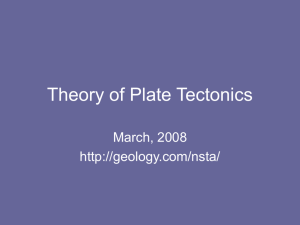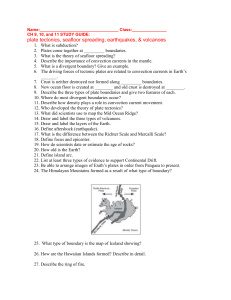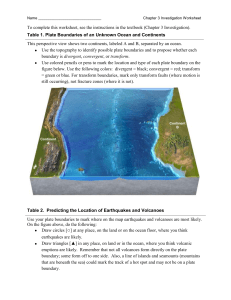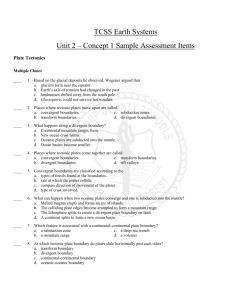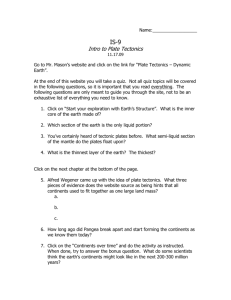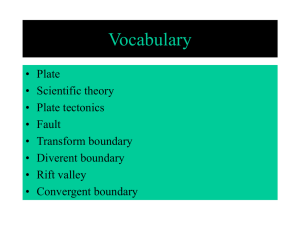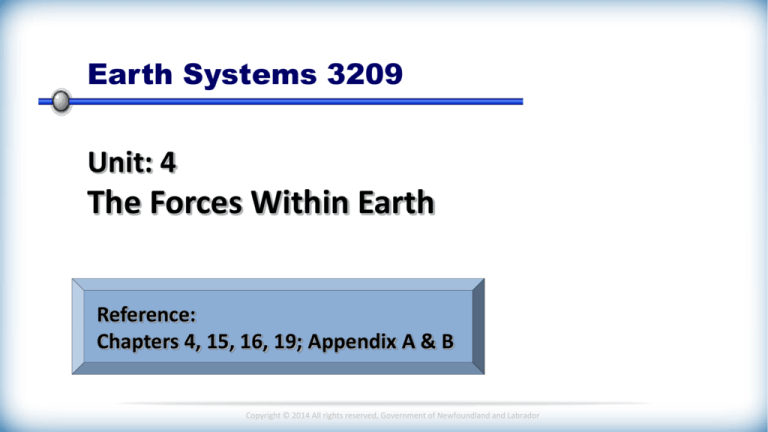
Earth Systems 3209
Unit: 4
The Forces Within Earth
Reference:
Chapters 4, 15, 16, 19; Appendix A & B
Copyright © 2014 All rights reserved, Government of Newfoundland and Labrador
Unit 4:
Topic 2.7
Plate Boundaries - Transform
Focus on . . .
describing a transform boundary.
drawing a transform boundary which demonstrates the
relative motion associated with this boundary.
Copyright © 2014 All rights reserved, Government of Newfoundland and Labrador
Plate Boundaries
According to the Plate tectonic theory, three
boundaries exist at the edges of tectonic plates.
1) Divergent Boundary (Ridge)
2) Convergent Boundary (Trench)
3) Transform Boundary
Text Reference:
Pages 526-539
Figure 19.17, pg. 528
Copyright © 2014 All rights reserved, Government of Newfoundland and Labrador
Plate Boundaries
Transform Boundary
A transform plate boundary is characterized by two
plates grinding past one another without the
construction or destruction of crust.
Convection currents exert shear forces on opposing
plates forcing them to slide past one another.
Lithosphere is neither created or destroyed at these
boundaries.
Copyright © 2014 All rights reserved, Government of Newfoundland and Labrador
Plate Boundaries
Transform Boundary
This type of plate boundary was discovered by J. Tuzo Wilson.
Wilson proposed the existence of transform faults to explain the
numerous narrow fracture zones and earthquakes found in the
crust.
He realized that ridges at divergent plate boundaries were not
perfectly linear and came to understand that transform faults
exist where segments of ridges are offset (see below).
Most transform faults occur where
oceanic ridges are offset on the
sea floor.
Transform Fault
Oceanic Ridge
(spreading center)
Copyright © 2014 All rights reserved, Government of Newfoundland and Labrador
Fracture Zone
Plate Boundaries
Transform Boundary
Earthquakes along such transform
faults are shallow focus earthquakes.
One of the largest such transform
boundaries occurs along the
boundary of the North American and
Pacific plates and is known as the
San Andreas Fault. Here the
transform fault cuts through
continental lithosphere.
Copyright © 2014 All rights reserved, Government of Newfoundland and Labrador
Plate Boundaries
Transform Boundary – Right Lateral “vs” Left Lateral
Copyright © 2014 All rights reserved, Government of Newfoundland and Labrador
Plate Boundaries
Copyright © 2014 All rights reserved, Government of Newfoundland and Labrador
Example 1:
What boundary is NOT associated with volcanic
activity?
(A) convergent
(C) rift
(B) divergent
(D) transform
Which plate boundary does shear forces dominate
resulting in tectonic plates sliding past one another?
(A) convergent
(C) transform
(B) divergent
(D) subduction
Copyright © 2014 All rights reserved, Government of Newfoundland and Labrador
Example 2:
What main type of force results in a transform fault?
(A) compression
(C) elastic
(B) shear
(D) tensional
Which of the following is an example of a transform
fault boundary?
(A) Alaskan thrust fault
(C) San Andreas fault
(B) Japan trench
(D) Tokyo normal fault
Copyright © 2014 All rights reserved, Government of Newfoundland and Labrador
Your Turn . . .
Take the time and complete the following questions . . .
(Solutions to follow)
Question:
Which occurs at a transform plate boundary?
(A)
(B)
(C)
(D)
collision of plates
formation of crust
sliding of plates along each other
subduction
Copyright © 2014 All rights reserved, Government of Newfoundland and Labrador
Solutions . . .
Question:
Which occurs at a transform plate boundary?
(A)
(B)
(C)
(D)
collision of plates
formation of crust
sliding of plates along each other
subduction
Copyright © 2014 All rights reserved, Government of Newfoundland and Labrador
Summary . . .
Overview of Points covered:
Transform Boundary:
proposed by Tuzo Wilson
shear forces cause plates slide past on another
right lateral “vs” left lateral
most occur along ocean ridges on the sea floor
no volcanic activity – just shallow focus earthquakes
lithosphere is neither created nor destroyed
example: San Andreas fault
Copyright © 2014 All rights reserved, Government of Newfoundland and Labrador


